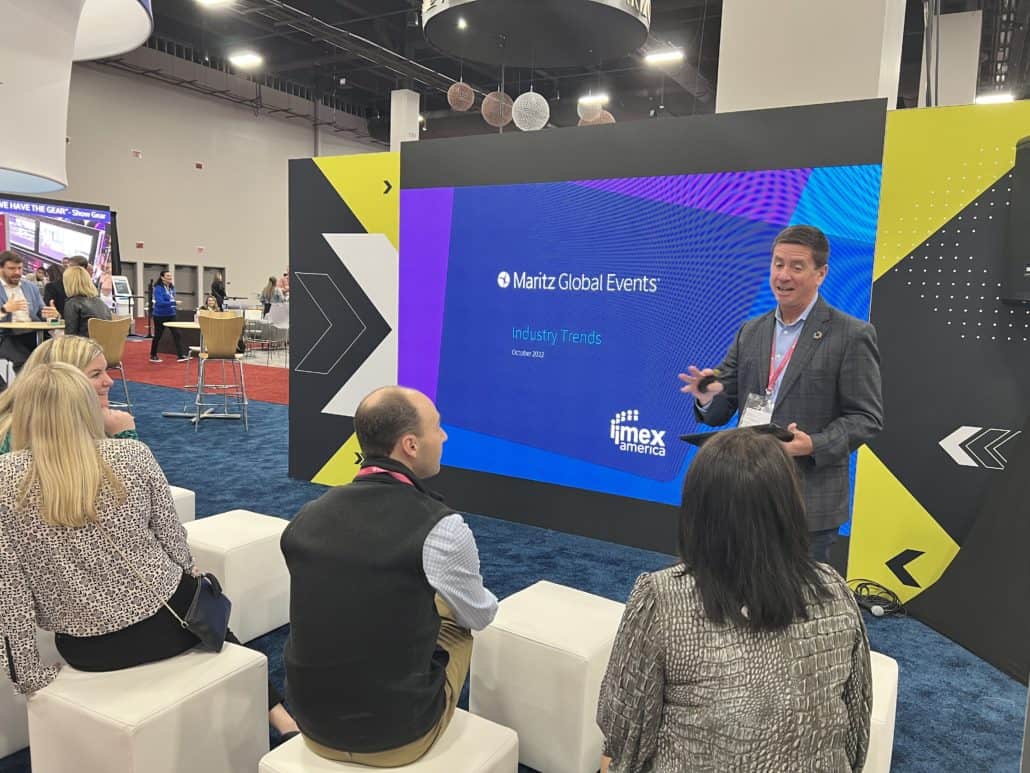
Industry trends are always a challenge to stay on top of — now more than ever as the pandemic wanes and meetings surge. A special IMEX Edition of Maritz Global Events’ 2022 Industry Trends report looks at what comes next after the pandemic forced the meetings industry to scrap its old playbook. Are you ready?
Industry trends were on the agenda at IMEX America this year. One new release launched at the event was Maritz Global Events‘ special IMEX America Industry Trends Report detailing some of the most provocative trends and issues affecting the meetings and events industry at this weird, sort-of-post-pandemic moment. While things are feeling a bit more like 2019, the reality is that people, including those who attend meetings and events, have undergone some major shifts. So what comes next? That’s what the Maritz Global Events team reached out to its customers’ participants to find out.
Here are a few of the top-line industry trends outlined in the report:
Industry Trend 1: Demand is Rebounding, But at What Cost?
The current state of the industry is optimistic — Maritz reports that 90.2 percent of its client events over the next six months are moving forward. And, says Maritz Global Events Enterprise Vice President and Chief Operating Officer, Steve O’Malley, “The guest satisfaction scores we’re seeing from events we are running are remarkably high.”
However, while the demand is strong, the industry still faces a lot of headwinds, including short-term planning horizons and compressed cycles. The pandemic-induced shortages and supply-chain issues continue to jack up prices, while planners and suppliers still struggle with lower quality services, products and facilities.
While inflation rates are stabilizing, they remain high, which means planners are facing increased fees for everything from hotels to air to AV and F&B. “Average airfare is up more than 33 percent year over year — these are big expenses people didn’t necessarily budget for 12 months ago,” says Maritz Global Events Enterprise Vice President and Chief Operating Officer, Steve O’Malley.
“We make sure our clients are aware of the rising costs and are budgeting appropriately.” And those high satisfaction scores prove that it is possible to work around the rising costs to keep the attendee experience from suffering any ill effects, he adds.
Finding new ways to manage expectations and identify workarounds that won’t hurt the attendee experience also become increasingly important as suppliers continue to struggle with staffing challenges, rising labor and goods costs, and inventory shortages.
Risk mitigation is top of mind for corporate meeting planners, as is rebuilding corporate culture as companies struggle to accommodate with new working environments and find new ways to re-engage key audiences. Associations are fielding a flood of last-minute registrations as they try to figure out how to determine attendee and exhibitor ROI, as well as other metrics, when historical data is no longer a reliable baseline.
Industry Trend 2: Who Is the New Attendee (and Are We Ready for Them)?
The Great Resignation has most affected those in the central attendee demographic — mid-career employees in the 30-45 age range — who also have experienced the highest turnover. About half of people over the age of 55 have already left the workforce.
With Gen Z poised to make up a third of the workforce by 2030, the time is now to prepare for an audience that wants to control their experience, not sit and listen to talking heads, as Maritz Global Events Enterprise Vice President, Brand, Experience and Innovation Greg Bogue says in the report. The new generations of attendees are different in other ways as well. For example, 83 percent of millennials want companies to align with their values, while more than 60 percent of Gen Z want to know where their stuff comes from — though they just want to be able to access that stuff and don’t necessarily want to own it — and believe in creating communities that are united by causes and interests, not economic or education levels.
What does this mean for meetings and events? As Bogue says in the report, “Events used to be something done to you. Then they were done for you. Now they’re done with you. In the future they’ll be done by you — the guest.” This means it’s time to get good at providing customized, hands-on experiences, peer collaboration, better networking experiences, more down time, and more flexible spaces for those networking and down time experiences, adds O’Malley. “Everyone has gotten used to the Amazon experience, which tailors your experience to your preferences. We have to have that same mindset, because people who are choosing to attend our events are consumers of events — we can’t afford to assume their preferences are the same as they were pre-pandemic. Autonomy and agency are what people are craving now.
“We now need to build events that are able to accommodate people based on where they are, with more autonomy, flexibility and purpose to how they spend their time,” says O’Malley. “We need to be focused on flexibility, choice and agency as we develop events for the future. We also need to commit to being the best we can be when it comes to sustainability, diversity, equity and inclusion, and corporate social responsibility. We now have the opportunity to build on the momentum that now exists.”
Industry Trend 3: Get Ready for New Privacy Laws
The only problem in gathering the new needs of today’s audience is that data-gathering also is becoming ever more complicated. First came the General Data Protection Regulation (GDPR) of 2018, then California launched its own data privacy law, the California Consumer Protection Privacy Act, which will be enforced starting next year. In addition to California, Virginia, Colorado, Connecticut and Utah also have privacy rights laws going into effect in 2023 — all of which could have implications for how event organizers can use the attendee data they collect.
“There are smart, less-invasive ways you can go about collecting audience data,” says O’Malley. “As an industry, and certainly our company, we have conquered the biggest hill with GDPR. We can’t be afraid to approach people to gather the information we need to design an experiences that is going to be atrractive and comfortable to them, to say ‘Hey, it’s been two years since we’ve had this experience. Tell us what you would like now.’ We need to collect and use the data with complete transparency, and use it smartly.”
Important questions to ask, the report says, are:
- Do you need this data?
- Is there any way you can anonymize or aggregate the data to protect individual identity?
- Are you being transparent about what you will do with the information? What controls do you have in place for its use?
- Can users reasonably anticipate how you plan to use their data?
- How far do you plan to apply your data protections — will they just apply to those in the affected states, or will you extend protections to all your attendees?
Download the full report here.
You May Also Be Interested In…
Accor Panel: Make Meetings Mindful and Meaningful
Survey: Meetings Activity Hits Post-Pandemic High










